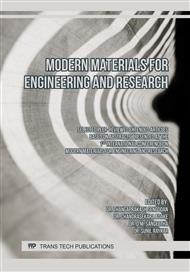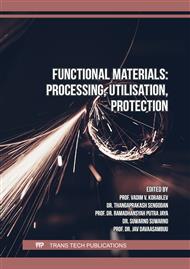[1]
C. Monticelli, Corrosion Inhibitors, in Klaus Wandelt, Encyclopedia of Interfacial Chemistry, Elsevier, Amsterdam, 2018, pp.164-171.
DOI: 10.1016/B978-0-12-409547-2.13443-2
Google Scholar
[2]
J. Kaur, N. Daksh, and A. Saxena, 'Corrosion Inhibition Applications of Natural and Eco-Friendly Corrosion Inhibitors on Steel in the Acidic Environment: An Overview', Arab. J. Sci. Eng., 47, 57–74, 2022.
DOI: 10.1007/s13369-021-05699-0
Google Scholar
[3]
A. Dutta, S.K. Saha, P. Banerjee, A.K. Patra, and D. Sukul, Evaluating corrosion inhibition property of some Schiff bases for MS in 1 M HCl: competitive effect of the heteroatom and stereochemical conformation of the molecule. RSC Adv. Vol. 6, p.74833–74844, 2016. doi.org/.
DOI: 10.1039/C6RA03521C
Google Scholar
[4]
Chemicals and waste, United Nations Department of Economic and Social Affairs, Sustainable Development. https://sdgs.un.org/topics/chemicals-and-waste
Google Scholar
[5]
J.C. Da Rocha, J.A.D.C.P. Gomes, and E. D'Elia, 'Corrosion inhibition of carbon steel in hydrochloric acid solution by fruit peel aqueous extracts', Corros. Sci., Vol. 52 p.2341–2348, 2010. doi.org/.
DOI: 10.1016/j.corsci.2010.03.033
Google Scholar
[6]
L. Li, X. Zhang, J. Lei, J. He, S. Zhang, and F. Pan, 'Adsorption and corrosion inhibition of Osmanthus fragran leaves extract on carbon steel', Corros. Sci. Vol. 63, p.82–90, 2012. doi.org/.
DOI: 10.1016/j.corsci.2012.05.026
Google Scholar
[7]
Y. Li, P. Zhao, Q. Liang, B. Hou, Berberine as a natural source inhibitor for mild steel in 1 M H2SO4, Appl. Surf. Sci., 252 (2005) 1245-1253.
DOI: 10.1016/j.apsusc.2005.02.094
Google Scholar
[8]
G. Quartarone, L. Ronchin, A. Vavasori, C. Tortato, and L. Bonaldo, 'Inhibitive action of gramine towards corrosion of mild steel in deaerated 1.0 M hydrochloric acid solutions', Corros. Sci. Vol. 64, pp.82-89, 2021.
DOI: 10.1016/j.corsci.2012.07.008
Google Scholar
[9]
R.T. Loto, 'Corrosion inhibition effect of non-toxic α-amino acid compound on high carbon steel in low molar concentration of hydrochloric acid', J. Mater. Res. Techn., vol. 8, no. 1, pp.484-493, 2019.
DOI: 10.1016/j.jmrt.2017.09.005
Google Scholar
[10]
C.A. Loto, O.O. Joseph, R.T. Loto, and A.P.I. Popoola, 'Corrosion inhibitive behaviour of camellia sinensis on aluminium alloy in H2SO4', Int. J. Elect. Sci., Vol. 9, no. 3, pp.1221-1231, 1221-1231.
Google Scholar
[11]
J. Fu, S. Li, L. Cao, Y. Wang, L. Yan, L. Lu, 'L-Tryptophan as green corrosion inhibitor for low carbon steel in hydrochloric acid solution', J. Mater. Sci., Vol. 45, pp.979-986, 2010.
DOI: 10.1007/s10853-009-4028-0
Google Scholar
[12]
A. Bouoidina, M. Chaouch, A. Abdellaoui, A. Lahkimi, B. Hammouti, F. El-Hajjaji, M. Taleb, A. Nahle, 'Essential oil of "Foeniculum vulgare": antioxidant and corrosion inhibitor on mild steel immersed in hydrochloric medium', Anti-Corros. Method M., Vol. 64, no. 5, pp.563-572, 2017.
DOI: 10.1108/acmm-10-2016-1716
Google Scholar
[13]
I. Hamdani, E. El Ouariachi, O. Mokhtari, A. Salhi, N. Chahboun, B. ElMahi, A. Bouyanzer, A. Zarrouk, B. Hammouti, J. Costa, 'Chemical constituents and corrosion inhibition of mild steel by the essential oil of Thymus algeriensis in 1.0 M hydrochloric acid solution', Der Pharm. Chem. Vol. 7, no. 8, pp.252-264, 2015.
DOI: 10.1007/s11164-013-1246-5
Google Scholar
[14]
Y. El Ouadi, A. Bouyanzer, L. Majidi, J. Paolini, J.M. Desjobert, J. Costa, A. Chetouani, and B. Hammouti, 'Salvia officinalis essential oil and the extract as green corrosion inhibitor of mild steel in hydrochloric acid', J. Chem. Pharm. Res., Vol. 6, no. 7, pp.1401-1416, 2014.
DOI: 10.1007/s11164-014-1802-7
Google Scholar
[15]
K. Boumhara, M. Tabyaoui, C. Jama, and F. Bentiss, 'Artemisia Mesatlantica essential oil as green inhibitor for carbon steel corrosion in 1 M HCl solution: Electrochemical and XPS investigations', J. Ind. Eng. Chem., Vol. 29, pp.146-155, 2015.
DOI: 10.1016/j.jiec.2015.03.028
Google Scholar
[16]
N. Lahhit, A. Bouyanzer, J.M. Desjobert, B. Hammouti, R. Salghi, J. Costa, C. Jama, F. Bentiss, and L. Majidi, 'Fennel (Foeniculum Vulgare) essential oil as green corrosion inhibitor of carbon steel in hydrochloric acid solution', Port. Electrochim. Acta., Vol. 29, no. 2, pp.127-138, 2011.
DOI: 10.4152/pea.201102127
Google Scholar
[17]
O. Kaczerewska, R. Leiva-Garcia, R. Akid, B. Brycki, Efficiency of cationic gemini surfactants with 3-azamethylpentamethylene spacer as corrosion inhibitors for stainless steel in hydrochloric acid, J. Mol. Liq. 247 (2017) 6–13.
DOI: 10.1016/j.molliq.2017.09.103
Google Scholar
[18]
R.T. Loto, 'Comparative study of the pitting corrosion resistance, passivation behavior and metastable pitting activity of NO7718, NO7208 and 439L super alloys in chloride/sulphate media', J. Mater. Res. Techn., Vol. 8, no. 1, pp.623-629, 2019.
DOI: 10.1016/j.jmrt.2018.05.012
Google Scholar
[19]
M. Goyal, S. Kumar, I. Bahadur, C. Verma, and E.E. Ebenso, 'Organic corrosion inhibitors for industrial cleaning of ferrous and non-ferrous metals in acidic solutions: A review,' J. Mol. Liq., Vol. 256, pp.565-573, 2018. doi.org/.
DOI: 10.1016/j.molliq.2018.02.045
Google Scholar
[20]
D. Sukul, A. Pal, S. Kr. Saha, S. Satpati, U. Adhikaria, P. Banerjee, 'Newly synthesized quercetin derivatives as corrosion inhibitors for MS in 1 M HCl: combined experimental and theoretical investigation', Phys. Chem. Chem. Phys., Vol. 20, pp.6562-6574, 2018. doi.org/.
DOI: 10.1039/C7CP06848D
Google Scholar
[21]
M. Abd El-Raouf, E. A. Khamis, T. H. Maram, and N. A. Negm, 'Electrochemical and quantum chemical evaluation of new bis (coumarins) derivatives as corrosion inhibitors for carbon steel corrosion in 0.5 M H2SO4', J. Mol. Liqs., Vol. 255, pp.341-353, 2018.
DOI: 10.1016/j.molliq.2018.01.148
Google Scholar
[22]
G. Babaladimath, V. Badalamoole, and S. T. Nanibewoor, 'Electrical conducting xanthan gum-graft-polyaniline as corrosion inhibitor for aluminum in hydrochloric acid environment', Mats. Chem. & Phys., Vol. 205, pp.171-179, 2018.
DOI: 10.1016/j.matchemphys.2017.11.008
Google Scholar
[23]
S. Bashir, V. Sharma, H. Lgaz, I.-M. Chung, A. Singh, and A. Kumar, 'The inhibition action of analgin on the corrosion of mild steel in acidic medium: a combined theoretical and experimental approach', J. Mol. Liqs., Vol., 263, pp.454-462, 2018.
DOI: 10.1016/j.molliq.2018.04.143
Google Scholar
[24]
A. Kahyarian, A. Schumaker, B. Brown, and S. Nesic, 'Acidic corrosion of mild steel in the presence of acetic acid: mechanism and prediction', Electrochim. Acta., Vol. 258, pp.639-652, 2017.
DOI: 10.1016/j.electacta.2017.11.109
Google Scholar
[25]
M. Chellouli, D. Chebabe, A. Dermaj, H. Erramli, N. Bettach, N. Hajjaji, M.P. Casaletto, C. Cirrincione, A. Privitera, and A. Srhiri, 'Corrosion inhibition of iron in acidic solution by a green formulation derived from Nigella sativa L', Electrochim. Acta., Vol. 204, 50-59, 2016.
DOI: 10.1016/j.electacta.2016.04.015
Google Scholar
[26]
L.K.O. Goni, and M.A. Mazumder, Green Corrosion Inhibitors, in A. Singh (ed.), Corrosion Inhibitors, IntechOpen, London, 2019. doi.org/.
DOI: 10.5772/intechopen.81376
Google Scholar
[27]
H. Li, Y. Qiang, W. Zhao, and S. Zhang, '2-Mercaptobenzimidazole-inbuilt metal-organic-frameworks modified graphene oxide towards intelligent and excellent anti-corrosion coating', Corros. Sci., Vol. 191, no. 109715, 2021.
DOI: 10.1016/j.corsci.2021.109715
Google Scholar



